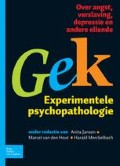Abstract
Onderzoekers laten zich inspireren door wat zijzelf en anderen hebben bedacht en geobserveerd. Soms gebeurt het dat buitenstaanders, geen onderzoekers dus, zich tegen het wetenschappelijk debat aan bemoeien met rare beweringen. Met dat laatste wordt gedoeld op beweringen die niet voortkomen uit eerder onderzoek, die niet zijn af te leiden uit bestaande theorieën en waarbij technieken worden gebruikt die nergens op lijken te slaan.
Access this chapter
Tax calculation will be finalised at checkout
Purchases are for personal use only
Preview
Unable to display preview. Download preview PDF.
Een eenhoorn onder de berkenboom
American Psychiatric Association (2004). Practice guideline for the treatment of patients with acute stress disorder and posttraumatic stress disorder. Arlington, VA: American Psychiatric Association Practice Guidelines.
Andrade, J., Kavanagh, D., & Baddeley, A. (1997). Eye-movements and visual imagery: A working memory approach to the treatment of post-traumatic stress disorder. British Journal of Clinical Psychology, 36, 209–223.
Baddeley, A.D. (1998). Human memory: Theory and practice. Needham Heights, MA: Allyn & Bacon.
Bisson, J.I., Ehlers, A., Matthews, R., Pilling, S., Richards, D., & Turner, S. (2007). Psychological treatments for chronic post-traumatic stress disorder: Systematic review and meta-analysis. British Journal of Psychiatry, 190, 97–104.
Bradley, R., Greene, J., Russ, E., Dutra, L., & Westen, D. (2005). A multidimensional meta-analysis of psychotherapy for PTSD. American Journal of Psychiatry, 162, 214–227.
Davidson, P.R. & Parker, K.C.H. (2001). Eye movement desensitization and reprocessing (EMDR): A meta-analysis. Journal of Consulting and Clinical Psychology, 69, 305–316.
Engelhard, I.M., Hout, M.A. van den, Janssen, W.C., & Beek, J. van der (2010). Eye movements reduce vividness and emotionality of images about feared future events. Behaviour Research and Therapy, 48, 442–447.
Engelhard, I.M., Hout, M.A. van den, & Schouten, E.G.W. (2006). Neuroticism and low educational level predictive for the risk of post-traumatic stress disorder in women after miscarriage or stillbirth. General Hospital Psychiatry, 28, 414–417.
Engelhard, I.M., Hout, M.A. van den, & Smeets, M.A.M. (2010). Taxing working memory reduces vividness and emotional intensity of images about the Queen’s Day tragedy. Ingediend ter publicatie.
Etten, M.L. van & Taylor, S. (1998). Comparative efficacy of treatments for posttraumatic stress disorder: A metaanalysis. Clinical Psychology and Psychotherapy, 5, 125–144.
Gunter, R.W. & Bodner, G.E. (2008). How eye movements affect unpleasant memories: Support for a working-memory account. Behaviour Research and Therapy, 46, 913–931.
Herbert, J.D., Lilienfeld, S.O., Lohr, J.M., Montgomery, R.W., O’Donohue, W.T., Rosen, G.M., & Tolin, D.F. (2000). Science and pseudoscience in the development of eye movement desensitization and reprocessing: Implications for clinical psychology. Clinical Psychology Review, 20, 945–971.
Holmes, E.A., Crane, C., Fennell, M.J.V., Williams, J.M.G. (2007). Imagery about suicide in depression – ‘Flash-forwards’? Journal of Behavior Therapy and Experimental Psychiatry, 38, 423–434.
Holmes, E.A., James, E.L., Coode-Bate, T., & Deeprose, C. (2009). Can playing the computer game ‘Tetris’ reduce the build-up of flashbacks for trauma? A proposal from cognitive science. PLoS ONE, 4, e4153- doi:10.1371/journal.pone.0004153.
Hout, M.A. van den, Engelhard, I.M., Rijkeboer, M., Koekebakker, J., Hornsveld, H. Toffolo, M., Akse, N., & Leer, A. (2010). Bilateral beeps and eye movements in EMDR: taxing of working memory and effects on negative recollections. Ingediend ter publicatie.
Hout, M.A. van den, Engelhard, I.M., Smeets, A.M., Hornsveld, H., Hoogeveen, E., Heer, H. de, Toffolo, M., & Rijkeboer, M. (2010). Counting during recall: Taxing of working memory and reduced vividness and emotionality of negative memories. Applied Cognitive Psychology, 24, 1–9.
Hout, M.A. van den, Muris, P., Salemink, E., & Kindt, M. (2001). Autobiographical memories become less vivid and emotional after eye movements. British Journal of Clinical Psychology, 40, 121–130.
Isaacs, J.S. (2004). Numerical distraction therapy: Initial assessment of a treatment for posttraumatic stress disorder. Traumatology, 10, 39–54.
Kavanagh, D.J., Freese, S., Andrade, J., & May, J. (2001). Effects of visuospatial tasks on desensitization to emotive memories. British Journal of Clinical Psychology, 40, 267–280.
Macklin, M.L., Metzger, L.J., Litz, B.T., McNally, R.J., Lasko, N.B., Orr, S.P., & Pitman, R.K. (1998). Lower pre-combat intelligence is a risk factor for posttraumatic stress disorder. Journal of Consulting and Clinical Psychology, 66, 323–326.
Maxfield, L., Melnyk, W.T., & Hayman, C.A.G. (2008). A working memory explanation for the effects of eye movements in EMDR. Journal of EMDR Practice and Research, 2, 247–261.
McNally, R.J. (1999). EMDR and Mesmerism. A comparative historical analysis. Journal of Anxiety Disorders, 13, 225–236.
Shapiro, F. (1995). Eye movement desensitisation and reprocessing. Basic principles, protocols, and procedures. New York: Guilford Press.
Trimbos-instituut (2003). Landelijke Stuurgroep Multidisciplinaire richtlijn angststoornissen 2003. Richtlijn voor de diagnostiek, behandeling en begeleiding van volwassen cliënten met een angststoornis. Utrecht.
Zimbardo, P.G. (2007). The Lucifer effect: Understanding how good people turn evil. New York: Random House.
Rights and permissions
Copyright information
© 2010 Bohn Stafleu van Loghum, onderdeel van Springer Media
About this chapter
Cite this chapter
van den Hout, M., Engelhard, I., Raymaekers, L. (2010). Een eenhoorn onder de berkenboom. In: Gek, Experimentele psychopathologie. Bohn Stafleu van Loghum, Houten. https://doi.org/10.1007/978-90-313-7640-7_6
Download citation
DOI: https://doi.org/10.1007/978-90-313-7640-7_6
Publisher Name: Bohn Stafleu van Loghum, Houten
Print ISBN: 978-90-313-7639-1
Online ISBN: 978-90-313-7640-7
eBook Packages: Dutch language eBook collection

